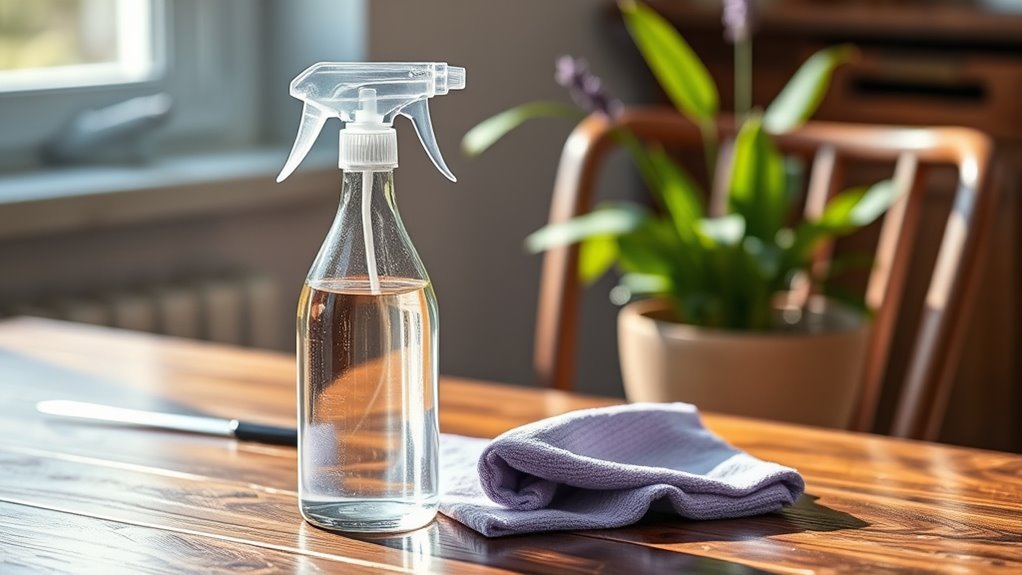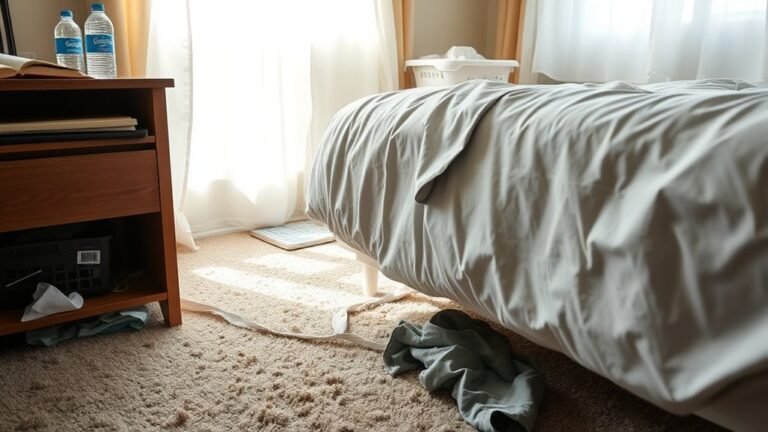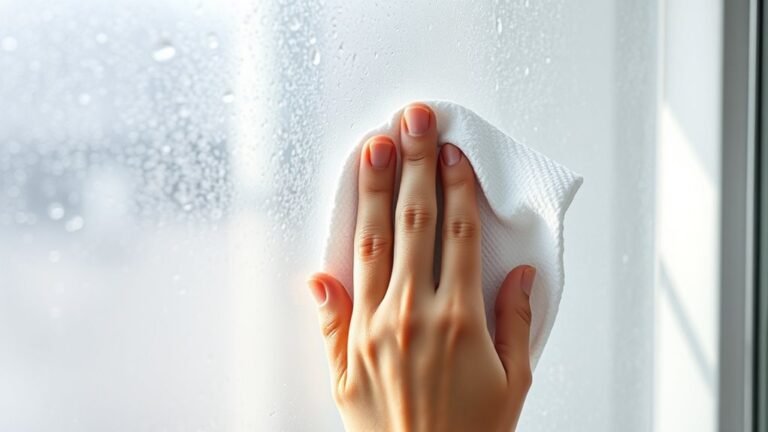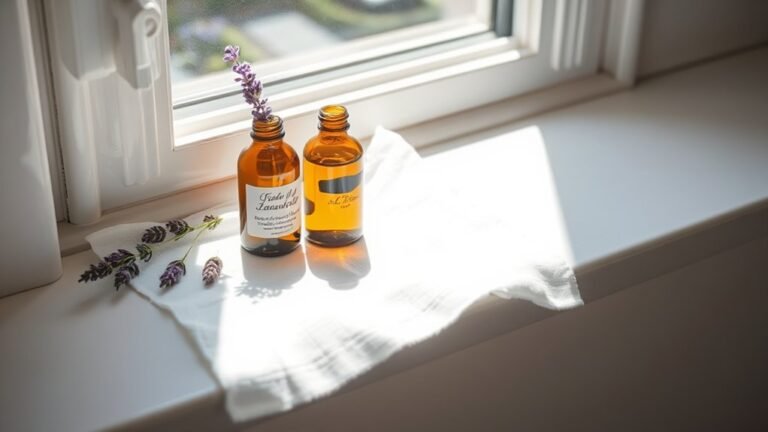DIY Cleaner for Chair Surfaces
You can create easy DIY cleaners for chair surfaces using natural ingredients like white vinegar, baking soda, and mild soap. For wooden chairs, mix vinegar and water to wipe away dirt gently. Fabric stains respond well to a baking soda paste or vinegar solution, while leather needs a diluted soap mix for safe cleaning. Acting quickly on spills helps prevent stains. If you want to keep your chairs looking fresh and learn how to apply these solutions perfectly, there’s more helpful advice ahead.
Essential Ingredients for DIY Chair Cleaners
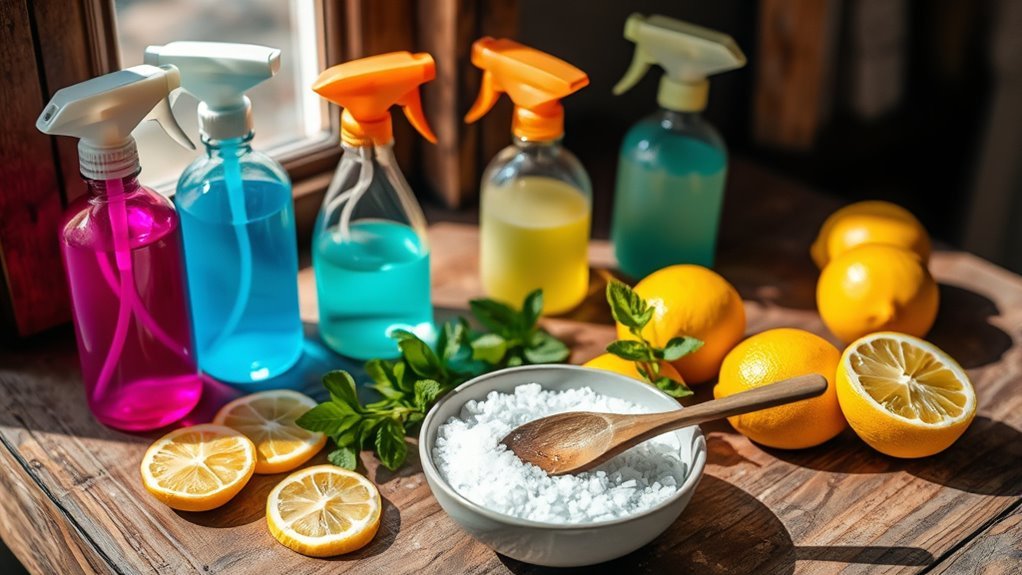
Before you mix your DIY chair cleaner, it’s important to know which ingredients work best for different types of chair surfaces. You want natural ingredients that are gentle yet effective, so you don’t have to worry about harsh chemicals damaging your furniture or the environment. Eco friendly options like white vinegar, baking soda, and essential oils give you the freedom to clean safely and sustainably. These ingredients tackle dirt, grime, and odors without leaving harmful residues behind. Keep in mind, some surfaces need milder solutions—leather, for instance, benefits from a mix of olive oil and lemon juice, while fabric chairs respond well to a baking soda and water paste. Choosing the right natural ingredients empowers you to maintain your chairs with confidence and care.
How to Clean Wooden Chairs Naturally
When you want to clean wooden chairs naturally, it’s best to use gentle ingredients that preserve the wood’s finish while removing dirt and grime. Start by dusting your chair with a soft cloth to avoid scratching. Mix equal parts white vinegar and water for a simple, effective cleaner that’s safe for most natural finishes. Dip a cloth into the solution, wring it out well, and wipe down the chair, paying attention to crevices. For extra wood care, finish by rubbing a small amount of olive oil or beeswax polish to nourish the wood and restore its shine. This approach keeps your wooden chairs looking fresh without harsh chemicals, letting you enjoy freedom in your cleaning routine while respecting the natural beauty of your furniture.
Homemade Solutions for Fabric Chair Stains

Three simple homemade solutions can help you tackle fabric chair stains effectively without resorting to harsh chemicals. When dealing with fabric upholstery, you want stain removal methods that respect your freedom to choose natural, safe options. Here’s what you can try:
- Mix equal parts white vinegar and water for a gentle cleaner.
- Use a baking soda paste to lift stubborn stains.
- Apply a mild dish soap solution with warm water for everyday spills.
- Dab stains immediately to prevent setting.
- Always test your solution on a hidden area first.
Cleaning Leather Chairs With Gentle DIY Cleaners
When cleaning leather chairs, you’ll want to use a mild soap solution to avoid damaging the surface. Adding a few drops of essential oils can help keep the leather smelling fresh and conditioned. Always apply your cleaner gently with a soft cloth to protect the material.
Mild Soap Solutions
Although leather requires special care, using a mild soap solution is one of the gentlest and most effective ways to clean your chair’s surface without causing damage. You’ll enjoy mild soap benefits like preserving leather’s natural oils while removing dirt and grime. If you want to avoid harsh chemicals, there are great soap alternatives such as castile soap or baby shampoo, which are gentle yet effective.
When using mild soap solutions, keep these tips in mind:
- Dilute the soap well with warm water
- Test on a small, hidden area first
- Use a soft cloth to apply and wipe gently
- Avoid soaking the leather to prevent damage
- Dry with a clean towel after cleaning
This method lets you maintain your leather’s beauty freely and safely.
Essential Oils Benefits
Since you want a natural way to clean and freshen your leather chair, essential oils offer a gentle yet effective solution. Their aromatic properties not only leave your chair smelling delightful but also create a calming atmosphere, enhancing your sense of freedom at home. Many essential oils act as natural disinfectants, helping to eliminate germs without harsh chemicals that could damage leather. By adding a few drops of oils like lavender, tea tree, or eucalyptus to your DIY cleaner, you boost its cleaning power while keeping it safe for your chair’s delicate surface. This approach lets you maintain your leather’s beauty and hygiene, all while embracing a more natural, liberating lifestyle—free from synthetic fragrances and toxins.
Soft Cloth Techniques
To keep your leather chair looking its best, you’ll want to use soft cloth techniques that protect its delicate surface while effectively cleaning. Choosing the right soft cloth types is key—they should be gentle enough to avoid scratches but absorbent for efficient dirt removal. Here are essential cleaning techniques to free your chair from grime without damage:
- Use microfiber cloths for their softness and durability.
- Opt for lint-free cotton cloths to prevent residue.
- Lightly dampen cloths with your DIY cleaner to avoid oversaturation.
- Wipe in gentle, circular motions to lift dirt without abrasion.
- Always test a small hidden area first to guarantee no discoloration.
Step-by-Step Guide to Applying Your DIY Cleaner
Before you start, make sure your chair surface is free of loose dirt or dust by wiping it down gently with a dry cloth. Next, pour a small amount of your DIY cleaner onto a soft cloth—never apply it directly to the chair to protect the material. Use gentle, circular motions to spread the cleaner evenly, focusing on any stained or grimy areas. Remember, your cleaning frequency depends on how often the chair’s used; stick to what feels right for your space. After application, let the surface air dry completely before sitting or placing anything on it. By mastering these application techniques, you’ll keep your chair fresh and extend its life while enjoying the freedom that comes with DIY care.
Tips for Maintaining Clean and Fresh Chair Surfaces
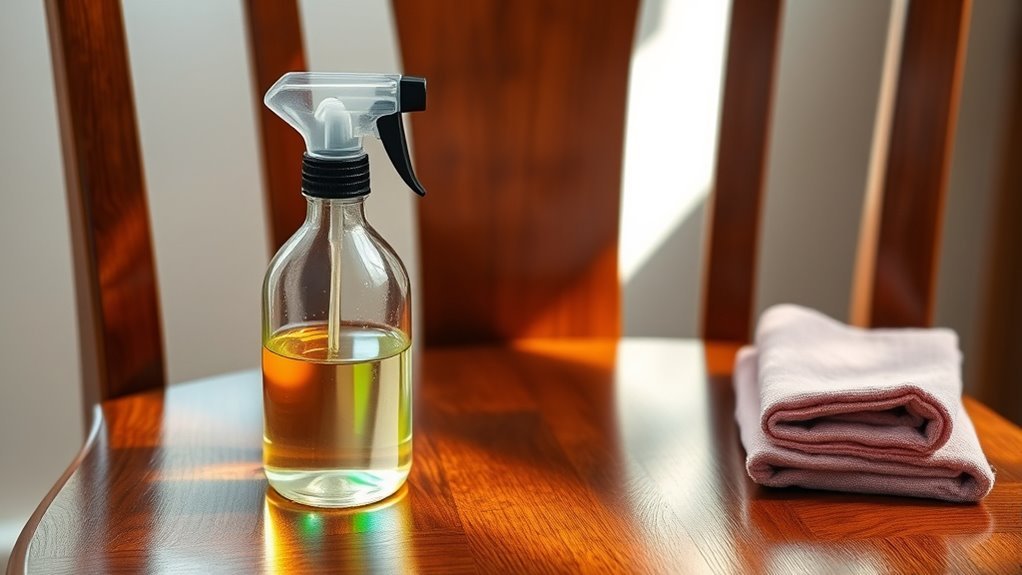
Although regular cleaning is key, maintaining your chair’s fresh appearance also involves simple daily habits. By embracing smart chair maintenance, you can enjoy freedom from constant deep cleaning and keep your surfaces protected longer.
Here are some quick tips for surface protection and lasting freshness:
- Wipe spills immediately with a soft cloth to prevent stains.
- Use chair covers or cushions to reduce direct wear.
- Avoid placing chairs in direct sunlight to prevent fading.
- Regularly dust surfaces to stop dirt buildup.
- Rotate chairs if they’re in heavy-use areas to distribute wear evenly.
Stick to these habits, and your chairs will stay looking clean and inviting without hassle, letting you focus on what really matters—your freedom and comfort.
Frequently Asked Questions
Can DIY Chair Cleaners Be Stored for Long Periods?
You might want to keep your homemade solutions fresh and ready, but they don’t always enjoy the luxury of eternal youth. When you store them in airtight storage containers, you can extend their shelf life, but it’s usually best not to keep them around for too long—think weeks, not months. This way, you maintain that sense of freedom, knowing your cleaner is effective and safe whenever you decide to freshen up your space.
Are DIY Cleaners Safe for Outdoor Chairs?
You can definitely use DIY cleaners on outdoor chairs, but you’ll want to contemplate the outdoor materials first. Some natural cleaners work great on wood or metal, but might not be as effective or safe on plastics or fabric. The cleaning effectiveness depends on the ingredients you choose. If you want a solution that’s both powerful and gentle, test it on a small spot to keep your freedom to enjoy your chairs without damage.
How Often Should I Deep Clean My Chairs?
Think of your chairs like a garden—they need regular care to stay vibrant. For chair maintenance, deep cleaning every three to six months is a good rule of thumb, depending on how often you use them and the environment they’re in. Adjust your cleaning frequency if you notice dirt buildup or stains. Keeping up with this routine lets you enjoy your chairs freely, without the hassle of unexpected grime or wear.
Can Essential Oils Be Added to DIY Cleaners?
Absolutely, you can add essential oils to your DIY cleaners! They not only offer natural cleaning fragrance options but also bring essential oil benefits like antibacterial and antifungal properties. Plus, they let you customize scents to match your mood or space, giving you freedom to create a fresh, inviting environment. Just make sure to dilute them properly, so your surfaces stay safe while smelling amazing!
What Should I Avoid Mixing in DIY Cleaning Solutions?
Before you mix anything, be careful—some combos can be dangerous. Never mix bleach with ammonia or vinegar; the toxic fumes can overwhelm you. Vinegar might seem harmless, but combined with bleach, it creates harmful chlorine gas. You want freedom in your cleaning, not risking your health. Stick to simple, safe ingredients, and avoid chemical reactions that could trap you in a hazardous situation. Safety lets you clean confidently and freely.
